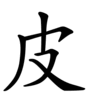皮
See also: 𪪍
| ||||||||
| ||||||||
Translingual
| Stroke order | |||
|---|---|---|---|
| Stroke order | |||
|---|---|---|---|
 | |||
Han character
皮 (Kangxi radical 107, 皮+0, 5 strokes, cangjie input 木竹水 (DHE), four-corner 40247, composition ⿻⿱丨又⿰丿乛)
- Kangxi radical #107, ⽪.
Derived characters
References
- KangXi: page 790, character 12
- Dai Kanwa Jiten: character 22823
- Dae Jaweon: page 1205, character 6
- Hanyu Da Zidian (first edition): volume 4, page 2753, character 1
- Unihan data for U+76AE
Chinese
| simp. and trad. |
皮 | |
|---|---|---|
Glyph origin
| Historical forms of the character 皮 | ||
|---|---|---|
| Western Zhou | Shuowen Jiezi (compiled in Han) | Liushutong (compiled in Ming) |
| Bronze inscriptions | Small seal script | Transcribed ancient scripts |
 |
 |
 |
Characters in the same phonetic series (皮) (Zhengzhang, 2003)
| Old Chinese | |
|---|---|
| 陂 | *pral, *prals |
| 詖 | *pral, *prals |
| 彼 | *pralʔ |
| 柀 | *pralʔ |
| 佊 | *pralʔ, *prals |
| 貱 | *prals |
| 跛 | *prals, *paːlʔ |
| 披 | *pʰral, *pʰralʔ |
| 鈹 | *pʰral |
| 帔 | *pʰral, *pʰrals |
| 鮍 | *pʰral |
| 耚 | *pʰral |
| 狓 | *pʰral |
| 翍 | *pʰral |
| 旇 | *pʰral, *brals |
| 秛 | *pʰral, *pʰrals |
| 紴 | *pʰralʔ, *paːl |
| 皮 | *bral |
| 疲 | *bral |
| 被 | *bralʔ, *brals |
| 髲 | *brals |
| 鞁 | *brals |
| 骳 | *mbralʔ |
| 波 | *paːl |
| 碆 | *paːl, *baːl |
| 菠 | *paːl |
| 簸 | *paːlʔ, *paːls |
| 駊 | *paːlʔ, *pʰaːlʔ |
| 頗 | *pʰaːl, *pʰaːlʔ, *pʰaːls |
| 坡 | *pʰaːl |
| 玻 | *pʰaːl |
| 破 | *pʰaːls |
| 婆 | *baːl |
| 蔢 | *baːl |
Pictogram (象形) – a hand (又) stripping the fur from an animal pelt (similar to 革). The pelt moved to the top left and became abstracted.
Etymology
- “skin”
- According to STEDT, 皮 (OC *m-pra-j) is likely derived from root 膚 (OC *pra) – further from Proto-Sino-Tibetan *p(r/j)a (“skin”) – and a voicing prefix – likely *m- which is found in several OC words for body parts like 鼻 (OC *m-bi[t]-s, “nose”), 肚 (OC *m-tˤaʔ, “belly”), 右 (OC *[ɢ]ʷəʔ-s (~ *m-qʷəʔ), “right-hand”) and 頭 (OC *[m-t]ˤo, “head”) (Baxter & Sagart, 2014).
- “pico-”
- Borrowed from English pico-.
Pronunciation 1
Definitions
皮
- skin (Classifier: 塊/块 m c; 層/层 m c); peel; shell
- 甩皮 [Cantonese] ― lat1 pei4 [Jyutping] ― to have flaky skin; to have peeling skin
- 樹皮/树皮 ― shùpí ― bark
- 香蕉皮 ― xiāngjiāo pí ― banana peel
- 牛則有皮,犀兕尚多。 [Classical Chinese, trad.]
- From: Commentary of Zuo, c. 4th century BCE, translated based on James Legge's version
- Niú zé yǒu pí, xīsì shàng duō. [Pinyin]
- Bulls still have skins; rhinoceroses and wild bulls still are many.
牛则有皮,犀兕尚多。 [Classical Chinese, simp.]- 誰家老馬棄城陰,毛暗皮乾瘦不禁。 [Vietnamese Literary Sinitic, trad.]
- From: 阮攸 (Nguyễn Du),〈城下棄馬〉(Thành hạ khí mã, "The Abandoned Horse at the Wall's Bottom") in 《南中雜吟》(Nam trung tạp ngâm "Assorted Recitations while in the South"), 1805-1812
- Thùy gia lão mã khí thành âm, mao ám bì can sấu bất câm. [Sino-Vietnamese]
- Someone's old horse is abandoned under the wall's shadow; he is gaunt, his hair darkened, his skin parched, beyond bearing.
- hide; leather
- 皮鞋 ― píxié ― leather shoes
- wrapper; cover; skin
- surface; top part
- 水皮 ― shuǐpí ― water surface
- rubber
- thin sheet
- outer; superficial
- sticky; glutinous
- soggy; non-crispy
- naughty; disobedient
- thick-skinned
- pico- (SI unit prefix)
- (Cantonese, colloquial) ten thousand dollars
Compounds
Derived terms from 皮
|
|
|
Pronunciation 2
Japanese
Etymology
kapa → kaɸa → kawa.
Noun
- skin
- 931–938, Minamoto no Shitagō, Wamyō Ruijushō (book 2, page 33)
- 皮 釋名云、皮. 音疲、加波
- 931–938, Minamoto no Shitagō, Wamyō Ruijushō (book 2, page 33)
References
- Minamoto, Shitagō; Kyōto Daigaku Bungakubu Kokugogaku Kokubungaku Kenkyūshitu (931–938) Shohon Shūsei Wamyō Ruijushō: Honbunhen (in Japanese), Kyōto: Rinsen, published 1968, →ISBN.
Korean
Etymology
From Middle Chinese 皮 (MC bˠiᴇ). Recorded as Middle Korean 피 (phi) (Yale: phi) in Hunmong Jahoe (訓蒙字會 / 훈몽자회), 1527.
Compounds
Vietnamese
This article is issued from Wiktionary. The text is licensed under Creative Commons - Attribution - Sharealike. Additional terms may apply for the media files.